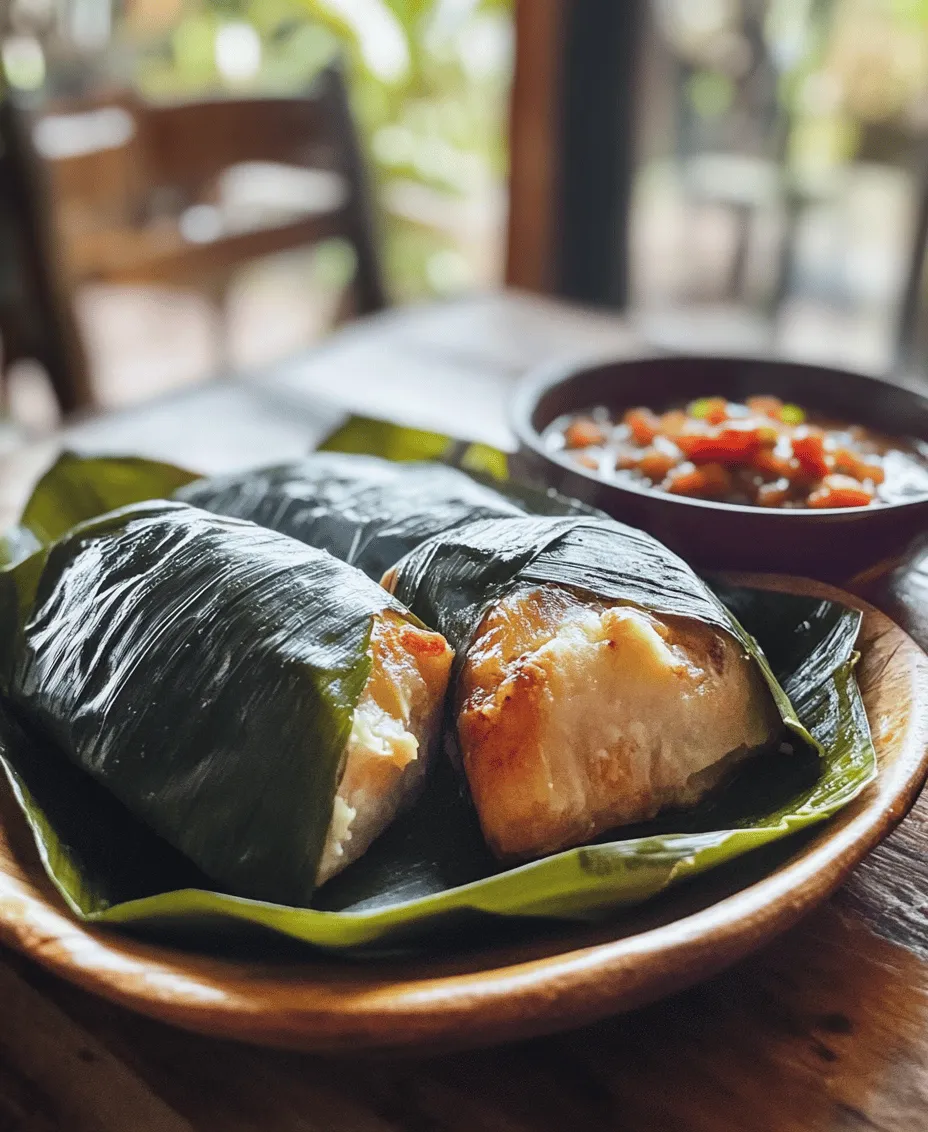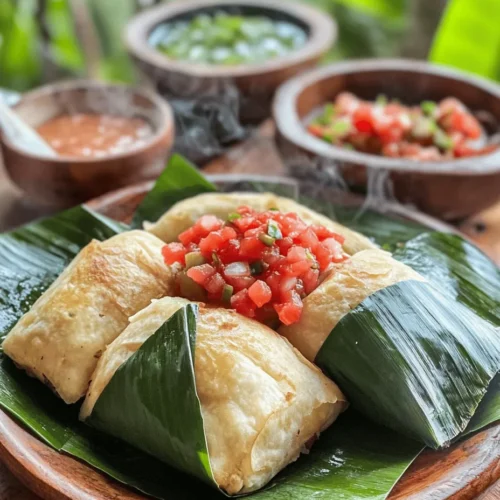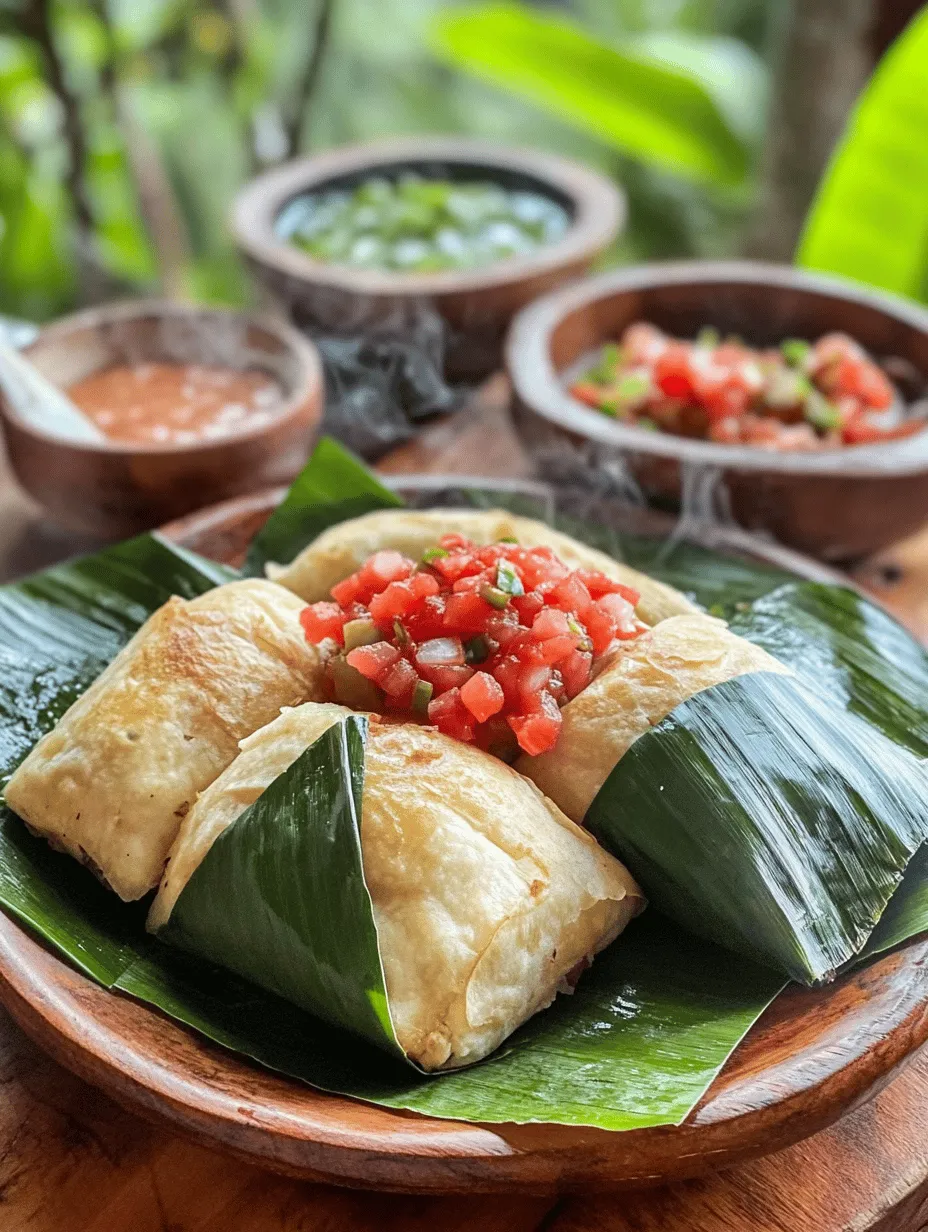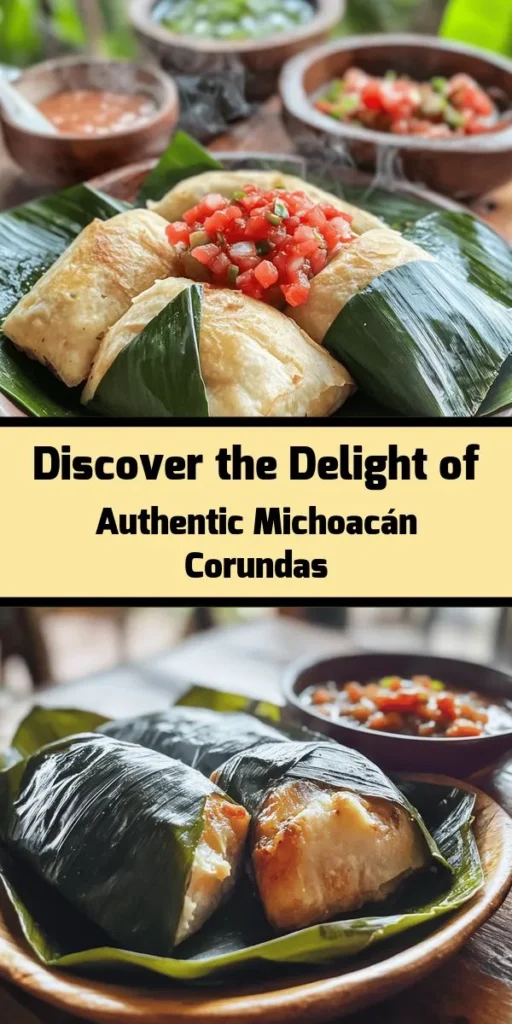Introduction
Michoacán, a picturesque state located in the heart of Mexico, is renowned for its rich culinary heritage that reflects a vibrant tapestry of indigenous traditions and modern influences. The cuisine of Michoacán is not just a feast for the senses; it is a living testament to the state’s history, culture, and its people’s deep connection to the land. Among its myriad offerings, corundas stand out as an emblematic dish that encapsulates the essence of Michoacán’s gastronomic identity.
Corundas are traditional corn dumplings that showcase the versatility and depth of flavor inherent in Michoacán cuisine. They are often compared to tamales, yet corundas possess a distinct character that sets them apart. The use of masa harina, a finely ground corn dough, is pivotal in crafting these delightful dumplings, which are typically filled with cheese and wrapped in banana leaves before being steamed to perfection. The combination of flavors and textures found in corundas makes them a beloved staple in Michoacán and a cherished treat enjoyed across Mexico.
In this article, we will delve into the world of corundas, exploring their historical significance, the unique flavors that define them, and the essential ingredients that contribute to their authenticity. We will also guide you through the initial steps of preparing this delectable dish, setting you on the path to experience the rich culinary traditions of Michoacán right in your own kitchen.
Understanding Corundas
Corundas are more than just a dish; they are a symbol of community and tradition in Michoacán. Historically, these corn dumplings have been prepared for special occasions, family gatherings, and festive celebrations. They reflect the agricultural bounty of the region, particularly the importance of maize, which holds a sacred place in Mexican culture.
The preparation of corundas can be traced back to indigenous communities that have inhabited Michoacán for centuries. These communities not only cultivated maize but also developed various methods of cooking it, leading to a diverse array of dishes. Corundas are particularly significant because they represent a blend of pre-Hispanic and colonial culinary practices, showcasing how food can evolve while retaining its roots.
When comparing corundas to similar dishes from other regions of Mexico, such as tamales or uchepos, one can appreciate their unique traits. While both tamales and corundas utilize masa, the latter is characterized by its thicker consistency and the distinct flavor imparted by the banana leaves used in the cooking process. Additionally, corundas are often served with various toppings, such as salsa or cream, enhancing their flavor profile and making them a versatile dish for any occasion.
The Ingredients of Corundas
Creating authentic corundas requires a few key ingredients, each playing a significant role in achieving the final dish’s characteristic taste and texture. Understanding these ingredients is essential for any home cook looking to replicate this traditional recipe.
Masa Harina
At the heart of corundas is masa harina, which is made from nixtamalized corn that has been dried and finely ground. This flour is the foundation for many Mexican dishes, including tortillas, tamales, and, of course, corundas. The significance of masa harina extends beyond mere sustenance; it is a fundamental element of Mexican identity and culture.
When using masa harina for corundas, it is crucial to select a high-quality product. The flavor and texture of the final dumplings depend heavily on the quality of the masa. A good masa harina will produce a dough that is pliable yet firm, allowing for easy shaping and wrapping.
Types of Cheese
Cheese is another vital component of corundas, adding richness and flavor to the dish. In Michoacán, two types of cheese are commonly used: queso fresco and Oaxaca cheese.
– Queso Fresco: This fresh cheese is crumbly and has a mild flavor, making it a popular choice for stuffing corundas. Its light texture allows it to melt beautifully when heated, enhancing the overall taste of the dumpling.
– Oaxaca Cheese: Known for its stringy texture and rich, creamy flavor, Oaxaca cheese brings a different dimension to corundas. It is often used for its delightful melting properties, providing a gooey, indulgent experience.
Choosing the right cheese for your corundas can significantly affect the dish’s flavor profile, so consider experimenting with different varieties to find your personal preference.
The Role of Banana Leaves
Banana leaves are not merely a wrapping for corundas; they play an essential role in the cooking process. When heated, banana leaves impart a subtle, earthy flavor to the dumplings, enhancing their taste and aroma. Additionally, they help to retain moisture during cooking, resulting in tender, flavorful corundas.
To prepare banana leaves for wrapping, they should be briefly passed over an open flame or boiled to make them pliable. This step is crucial, as it prevents the leaves from tearing and ensures a proper seal around the masa.
Importance of Choosing Quality Ingredients
To create truly authentic corundas, it is vital to choose fresh, high-quality ingredients. The flavors of the masa, cheese, and banana leaves work in harmony to produce a dish that reflects the culinary heritage of Michoacán. By sourcing the best ingredients, you not only enhance the taste of your corundas but also pay homage to the traditions and techniques passed down through generations.
Step-by-Step Guide to Making Corundas
Now that we have explored the cultural significance and key ingredients of corundas, let’s dive into the initial steps involved in making this traditional dish. The process of preparing corundas may seem daunting at first, but with a little patience and attention to detail, you can master this delicious recipe.
Preparing the Masa
The first step in making corundas is preparing the masa. This involves mixing masa harina with water and other ingredients to create a dough that is both flavorful and pliable.
1. Measure the Masa Harina: Start by measuring out the desired amount of masa harina. A typical recipe may call for about 2 cups, but feel free to adjust based on the number of corundas you want to make.
2. Add Water: Gradually add warm water to the masa harina. The amount of water may vary, but a good starting point is about 1 to 1.5 cups. Mixing the water in gradually helps you achieve the right consistency without over-hydrating the masa.
3. Mix Thoroughly: Using your hands or a wooden spoon, mix the masa harina and water until well combined. The dough should be moist but not sticky. If it feels too dry, add a little more water; if it’s too wet, sprinkle in some additional masa harina.
4. Knead the Dough: Once the masa is mixed, knead it for a few minutes to develop its texture. The dough should become smooth and elastic, which is crucial for forming the corundas.
Tips for Achieving the Right Dough Consistency
Getting the masa to the right consistency is essential for successful corundas. Here are some tips to help you achieve the perfect dough:
– Texture Check: The dough should hold its shape when molded, yet still be soft enough to spread easily. If it crumbles, it may need more water; if it sticks excessively, it may need more masa harina.
– Resting Time: Allow the masa to rest for about 10-15 minutes after mixing. This resting period allows the gluten to relax, making it easier to work with.
Incorporating Butter
Adding fat to the masa is a key step in enhancing the flavor and texture of corundas. Butter or shortening can be incorporated into the dough to provide richness and moisture.
1. Melt the Butter: Start by melting about 2 tablespoons of unsalted butter. This can be done in a microwave or on the stovetop.
2. Add to the Masa: Once melted, pour the butter into the masa and mix it in thoroughly. The fat will help keep the corundas tender and add a delightful flavor.
3. Knead Again: After incorporating the butter, knead the masa again for a few minutes to ensure even distribution. The dough should feel smooth and pliable.
Kneading Techniques for Optimal Texture
Kneading is a crucial part of preparing the masa for corundas. Here are some techniques to achieve the best possible texture:
– Use the Palm of Your Hand: When kneading, use the palm of your hand to push and fold the dough. This technique helps to develop the gluten, resulting in a firmer yet tender masa.
– Be Gentle but Firm: While it’s important to knead the dough adequately, be careful not to overwork it. Over-kneading can lead to a tough texture, which is not desirable in corundas.
– Check for Elasticity: As you knead, periodically check the dough for elasticity. It should spring back slightly when pressed, indicating that it is ready for shaping.
With these foundational steps covered, you are well on your way to creating authentic corundas that celebrate the culinary traditions of Michoacán. In the next part of this article, we will delve deeper into the wrapping and cooking process, ensuring you have all the tools you need to bring this delicious dish to life.

Shaping the Corundas
Once you have mixed your masa to the right consistency, it’s time to shape the corundas. This step is crucial as the traditional triangular shape not only holds the filling but also ensures even cooking.
Visual and Descriptive Guide to Shaping the Masa
To shape the masa, take a small portion, about the size of a golf ball. Flatten it gently in the palm of your hand, creating a disc. The thickness should be about 1/4 inch. Next, place a spoonful of your desired filling—whether it’s cheese, beans, or a savory meat mixture—at the center of the disc.
Now, fold the sides of the masa over the filling to create a triangular shape. Pinch the edges securely to prevent any leakage during cooking. The final corunda should resemble a small triangle, similar to an envelope. Make sure the seams are tightly sealed.
Importance of the Triangular Shape for Cooking and Presentation
The unique triangular shape of corundas is not just for aesthetics. This design allows for better steam circulation, which is essential for cooking the masa evenly. Additionally, the shape provides a beautiful presentation when served, showcasing the vibrant fillings peeking out from the masa. This traditional form also aids in the easy handling of corundas when they are served, making them perfect for gatherings and communal meals.
Steaming the Corundas
With your corundas shaped and ready, the next step is steaming. Proper steaming is essential to achieve the ideal texture: soft yet firm enough to hold their shape.
Setting Up the Steamer for Best Results
For steaming, you can use a traditional Mexican steamer (olla de vapor) or any large pot with a lid and a steaming rack. Fill the bottom of your pot with water—enough to create steam but not so much that it touches the corundas. If using a traditional steamer, layer the corundas in the basket, ensuring they are not overcrowded. Leave enough space between each corunda to allow the steam to circulate freely.
To add an extra layer of flavor, you can throw in a few corn husks or a couple of bay leaves in the water. This will infuse the corundas with a subtle aroma as they steam.
Timing and Temperature Tips for Perfect Cooking
Cover the steamer with a lid and bring the water to a gentle boil. The corundas will need to steam for about 30 to 40 minutes. It’s important to check the water level occasionally, ensuring it does not evaporate completely. Maintain a steady steam throughout the cooking process.
To check for doneness, carefully remove one corunda and allow it to cool slightly before tasting. The masa should be cooked through and have a pleasant, slightly chewy texture. If necessary, return the corundas to the steamer for an additional 5-10 minutes.
Serving Suggestions
Corundas are traditionally served in a variety of ways, making them a versatile dish that can fit into any meal or occasion.
Traditional Ways to Serve Corundas in Michoacán
In Michoacán, corundas are often served with a side of salsa verde or salsa roja, which adds a wonderful kick to the dish. They can also be garnished with crumbled cheese, sour cream, or a sprinkle of fresh cilantro.
Pairing Corundas with Salsas and Other Condiments
Pair your corundas with vibrant salsas that range from mild to spicy. A traditional tomato salsa with onions and cilantro complements the flavors beautifully. For those who enjoy a bit more heat, a smoky chipotle salsa can elevate the dish to new heights.
Other accompaniments include pickled onions or jalapeños, which add a delightful crunch and acidity, balancing the richness of the masa.
Suggestions for Side Dishes that Complement Corundas
To create a well-rounded meal, consider serving corundas alongside a fresh salad or a light soup. A simple cucumber and tomato salad dressed with lime juice and salt can provide a refreshing contrast. Alternatively, a light broth-based soup, such as caldo de pollo, can be served as a starter, preparing your guests for the delicious main dish to come.
Nutritional Benefits of Corundas
Corundas are not only a delicious treat but they also offer several health benefits due to their primary ingredient—corn.
Overview of the Health Benefits of Corn and the Ingredients Used
Corn is a whole grain that provides a good source of fiber, which is essential for digestive health. It also contains essential vitamins and minerals such as vitamin B, magnesium, and potassium. When combined with other ingredients like beans or cheese, corundas become a more balanced meal, incorporating proteins and healthy fats.
Discussion on the Nutritional Profile of Corundas
A typical corunda can vary in calories depending on the fillings used, but they are generally low in fat and high in carbohydrates, making them an excellent source of energy. When made with nutritious fillings, corundas can easily fit into a healthy diet, providing essential nutrients without excessive calories.
How Corundas Can Fit into a Balanced Diet
Incorporating corundas into your meals can be a fantastic way to enjoy traditional flavors while maintaining a balanced diet. Pairing them with fresh vegetables, lean proteins, and healthy fats can enhance their nutritional profile and help create satisfying, wholesome meals.
Cultural Significance of Corundas
Corundas are more than just a dish; they are a symbol of community and tradition in Michoacán.
Role of Corundas in Family Gatherings and Celebrations
In Michoacán, corundas are often made for family gatherings and special occasions. They are a dish that brings people together, whether for a festive celebration or a cozy family meal. The process of making corundas can be a communal activity, with family members collaborating in the kitchen, sharing stories, and passing down recipes through generations.
Stories and Anecdotes About Corundas from Michoacán Residents
Many Michoacán residents have fond memories associated with corundas. Some recall their grandmother’s secret recipe that was passed down, while others remember the excitement of gathering around the table to enjoy this beloved dish. These anecdotes highlight the emotional connection to food and the importance of preserving cultural heritage through cooking.
The Importance of Preserving Traditional Recipes in Modern Cooking
In today’s fast-paced world, traditional recipes like corundas serve as a reminder of our roots. They connect us to our culture and history, and preserving these recipes is crucial for future generations. By making corundas at home, you’re not only enjoying a delicious meal but also contributing to the preservation of culinary traditions that enrich our lives.
Conclusion
Corundas are a unique and cherished dish that showcases the rich culinary heritage of Michoacán. Their distinctive triangular shape, flavorful fillings, and cultural significance make them a delightful addition to any meal. By making corundas at home, you embrace the authentic flavors of Michoacán and honor the traditions that have been passed down through generations.
The joy of preparing and sharing corundas is an experience that transcends mere cooking; it is a celebration of culture, family, and community. Whether you’re experimenting with different fillings or serving them at a gathering, corundas offer a taste of home that invites everyone to the table. So, why not try your hand at making corundas today? Explore these authentic flavors and create lasting memories with loved ones.



